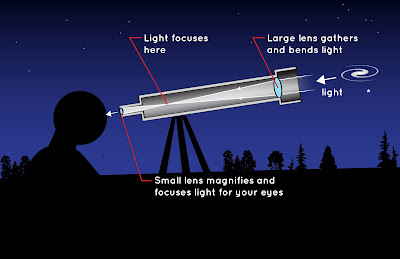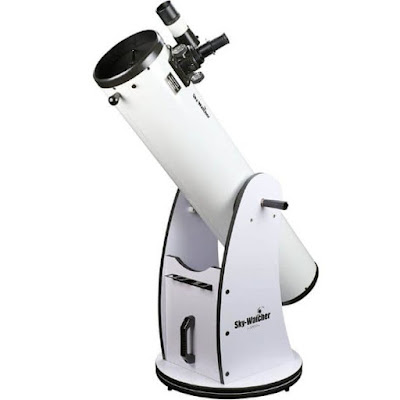Newly arrived to my blog? Want to know more about me before you dive into my posts? Why not visit the home page first and start your exploration from there:
https://undersouthwestskies.blogspot.com/2025/01/welcome-to-my-new-astronomyastrophotogr.html
And welcome.
Welcome to 'UnderSouthWest Skies'. Thanks for stopping by. I hope you find the experience worthwhile. This blog post has been written from my own 'beginner perspective' after doing lots of reading on various basic astronomy and astrophotography topics of interest to beginners. In getting my head around it all, I may have got odd bits slightly wrong; but, like you, I am on a leaning journey, so please forgive any unintentional errors. Also, just because I have gone down a particular road regarding equipment, it doesn't mean that I have chosen the 'CORRECT' route!
Meanwhile, clear skies to you. Take care and thanks for visiting Steve aka PlymouthAstroBoy
How does a telescope work - the simple version!
I hope!
Basic question – “What is a telescope?”
Its an optical tube assembly (OTA). It uses lenses or
mirrors or both to view distant objects. Gathered light is concentrated and
brought to focus at an eyepiece. All these densely packed light photons in a
small area show an image. An eyepiece at this point on a focuser shows the
image collected. Every telescope has similar components in its construction –
optics tube, mount, objective lens, eyepiece, focuser, diagonal and an internal
mirror/lens system that directs light inputs.
Basic question 2 – “What are the different types of telescopes
available to us?”
Every type of OTA controls entering light to the objective
lens in different ways. If you want to buy a telescope you HAVE TO understand
the differences between each type, their advantages, and disadvantages before
deciding the type you are going to get.
Traditionally there are three types of telescopes –
refractor, reflector and compound.
What follows now is written by a beginner, me, for other beginners
(you) - i.e. those of you thinking of getting your first telescope. I stress
now that I may not have all this correct but I have done my best. I am trying
to give a ‘one stop shop’ so to speak. The aim is to give an overview and start
you on your ‘thinking journey’ towards buying your first telescope.
So, lets jump
straight in: But before I do so a polite note: the illustrations below are just that, illustrations, not particular recommendations!
And a tip: if you are a beginner to astronomy and thinking of buying a first telescope, I suggest you read this blog post first and afterwards come back to this one. The first blog to read is https://undersouthwestskies.blogspot.com/2025/01/beginners-guide-to-buying-your-first.html
1.
Refractor telescopes
First type to be invented, they employ a glass lens at the end of a tube to obtain a magnified view of the sky. One of the best collections of old refractor telescopes I have seen was at the Galileo Museum in Florence. Stunning instruments.
Anyway, refractors are popular with many appealing qualities
and are a good first telescope option. They have a lens at the front of the
optical tube and an eyepiece at the back. Achromat lens systems involving two
lenses are not colour dependent and bring all coloured light to a focus.
However, Apochromatic lens systems involving four pieces of glass, are more
expensive and give a far superior image quality and focus. Generally,
refractors deliver sharper and brighter images per inch of aperture than other
designs because the lenses are more efficient and other designs ave a secondary
mirror up front that blocks some incoming light.
Watch an animation of light passing through a
refractor. https://skyandtelescope.org/wp-content/uploads/Refractor-animation-720p.mp4
Advantages:
·
Lightweight
·
Easy to use
·
Generally more rugged
because their lenses are less likely to fall out of alignment - Optical tube is sealed from elements
·
Sharp views
·
Require little maintenance
·
Interchangeable eyepieces offer varying magnifications
·
Good portability
·
Good as ‘grab and go’ instruments because unlike
other telescope types, refractors reach the temperature of the outside air more
rapidly and are therefore ‘ready to work’ far more quickly
·
They don’t need collimation (lens alignment)
·
Better at image contrasting because no light is
blocked as it passes through the lenses. This is much better for observing
planets and double stars where good image contrast is required to be able to
see finer details
·
Good for seeing the solar system, bright deep
space objects (DSO’s), planets and double stars
·
Disadvantages:
·
Aperture is king – so very large lens refractors
are expensive and often unmanageable for beginner amateurs – for amateurs,
refractor apertures will be between 60 – 150mm in diameter
·
Optics quality affects price and cheap
refractors are often disappointing, so refractors tend to be expensive than other
telescope types
·
Refractors can suffer from something called
‘false colour’ – a bright star looks somewhat rainbow tinted and blurry rather
than a sharp point of light.
·
The longer the refractor tube, the higher the
pivot point needs to be on the tripod and the taller and heavier tripod you
require (remember the eyepiece is at the end of the optical tube).
Other points to consider with refractors include:
·
Small refractors < than 90mm are best suited
for wide sky views. Planets will appear small. Brighter galaxies and nebula
will be visible under dark sky conditions.
·
Larger refractors >100mm diameter will give
lots of deep space object viewing – galaxies, globular clusters, and nebulae.
Surface colours will be seen on planets such as Mars, Jupiter, and Saturn.
Sharp lunar views with good detailed definition on craters and mountain ridges
will be seen.
A decent refractor on a sturdy mount and tripod will give thrilling stargazing experiences for many years.
How a refractor telescope works: Copyright Liverpool
Astronomical Society
2.
Reflective telescopes
The second type of telescope, a reflector, was by all
accounts invented by Issac Newton and so they tend to be called Newtonian
reflectors. Reflectors use large mirrors instead of lenses. An open tube at
the front and a curved mirror at the bottom of the optic tube (the primary mirror).
Entering light is reflected back inside the tube to an angled smaller, flat
secondary mirror, near the top of the open tube. And it is here that we find
the eyepiece. This allows apertures to be far bigger than refractor scopes.
Reflector telescopes can be mounted on tripod (smaller
models) or on a rotating base which sits on the floor (for bigger models and
these are known as Dobsonian telescopes. These tend to be the best value
for money and give rewarding deep sky views. Dobsonian telescopes are simple
with no wires or batteries. You point the telescope at what it is you want to
see. You can add GOTO controls.
Advantages:
·
Dobsonian telescopes tend to offer the best
value for money overall as they reflect true light as opposed to bending it. Tend
to be least expensive
·
give good sharp and contrasty deep sky views;
·
Best for viewing fainter distant objects such as
galaxies and nebulae
·
Easy to adjust and modify
·
Simple with no wires or batteries
·
Some models can have motors and GOTO facilities added
at later date
·
Work well in focal length ranges from F/4 to F/8
– they deliver wide fields of view relative to their aperture
Disadvantages:
·
They are sensitive to bumping and so mirrors may
need regular adjusting – collimation – as the mirrors occasionally fall out of
alignment. For beginners collimation can sometimes be frustrating
·
They can be heavy and bulky – awkward to move
and store
·
The largest models may require a set of steps to
reach the eyepiece viewer when viewing objects towards the sky zenith
·
They can suffer from the ‘coma effect’ where stars
at the very edge of the field of view look long and thin
·
Being open tubes they can be great dust
collectors if you are not careful – so make sure wne storing them they have
their dust cap on
·
For beginners, they can be confusing because
they flip and invert the image being viewed – so if viewing the moon – that bit
of surface being viewed is flipped left to right and, actually being viewed
upside down!
Watch an animation of light passing through a
reflector. https://skyandtelescope.org/wp-content/uploads/Reflector-animation-720p.mp4
For really good briefings about Newtonion and Dobsonion
reflectors visit these sites:
https://meteorwatch.org/newtonian-telescopes-simple-guide-reflector-telescopes/
https://meteorwatch.org/dobsonian-telescopes/
How a Newtonian reflector telescope works: copyright
Liverpool Astronomical Society
3.
Catadioptric (compound) telescopes
Catadioptric Telescopes have a combination of mirrors which
have a hole in the middle of them and lenses. Light is sent back through a hole
in the main mirror. Invented in the 1930’s, like refractor telescopes, the front
end is pointed skywards and you look into the telescope at the rear end via
interchangeable eyepieces. They give a comparatively more magnified view for a
given size of eyepiece. Basically, they combine the best characteristics of a
refractor and reflector telescope. Two types are Schmidt-Cassegrains and
Maksutov-Cassegrains.
Watch an animation of light passing through a compound telescope. https://skyandtelescope.org/wp-content/uploads/Compound-animation-720p.mp4
Advantages:
·
Short and compact (shorter in length) so easier
to store and easier to ‘grab and go’
·
Probably the best combination of optics
·
Can use lighter mounts – so overall easier to
transport as a set up
·
A sealed unit so no dust traps
·
Maksutov-Cassegrain or Schmidt- Cassegrain
telescopes give excellent views of planets and moon; with good sky conditions,
they show clearly the rings of Saturn and colour bands of Jupiter. Even the
polar caps on Mars! With a long focal length in a very compact tube, they are
excellent for all near and deep space viewing except for distant
deep space objects
·
Good first choice of telescope for many as they
are good compromise between large aperture of reflectors and manageable size
Disadvantages:
·
Comparatively heavy
·
Need periodic tweaking to ensure mirrors are
lined up – collimation again.
·
Larger magnifications mean that objects being
viewed will move more quickly out of view – so they are best with electronic
tracking mounts
·
Most Schmidt-Cassegrains have an F/10 focal ratio
so they don’t always produce wide low power fields of view.
·
Cost wise – aperture for aperture, catadioptric
telescopes lie midway between refractors and reflectors.
·
Take a long time to cool down to the outside
night time temperature so they aren’t a ‘grab and go’ type telescope in that
sense
How a Maksutov-Cassegrain telescope works: copyright
Celestron
I hope this helps you
gain some understanding of the different types. There are some excellent
YouTube tutorials about different types of telescope for beginners as well.
https://www.youtube.com/watch?v=JI5id4xksSU Anything by Trevor Jones is always well worth watching! As is anything produced by Rother Valley Optics in my humble opinion https://www.youtube.com/watch?v=ga0lgrSPxh0
And a simple readable summary - try this one: https://www.widescreen-centre.co.uk/blog/best-telescopes-for-beginners.html
Next linked blog post? https://undersouthwestskies.blogspot.com/2025/01/my-beginners-guide-to-choosing-mount.html












No comments:
Post a Comment
Hello, thanks for visiting us. If you want to drop a comment or get in touch - leave a comment and we will get back to you asap. Bye